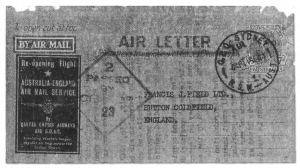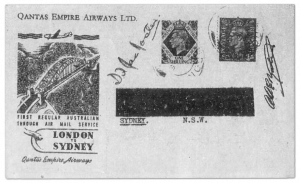The possibilities of the aeroplane as a swift means of communication throughout the remote parts of Australia were envisaged during the first world war, and in 1919 shortly after the termination of hostilities, the Commonwealth Government commissioner two well-known aviators, P. J. McGinness and Hudson Fysh (the latter now Chairman and managing-director of Q.E.A.) to survey the route between Darwin and Longreach, with a view to establishing a mail and passenger service over the wild and sparsely populated territory of Western Queensland and North Australia. In the following year the famous pioneer air concern was born, under the title of the Queensland and Northern Territory Aerial Service, and its initials were soon to become known wherever aviation matters were discussed.
The original Qantas fleet consisted of two war-type biplanes with a cruising speed of about 65 miles per hour, and these were piloted by McGinness and Hudson Fysh, with the assistance of W. A. Baird as engineer. With this small staff Qantas covered the whole of Western Queensland as air-taxi men, and their experience was to prove a valuable factor as the Company began to expand their field of operations.
In 1922 the Australian Government called for tenders for an experimental weekly airmail service between Charleville and Cloncurry, a distance of 577 miles. Qantas obtained this contract and opened the service on November 2nd of that year. A certain, proportion of first-flight covers in both directions received a vignette inscribed “FIRST QUEENSLAND AERIAL MAIL.” This route was extended on Jan. 2nd via Duches and Mount Isa, to Camooweal, an addition of 248 miles, but the first mails were not carried on that section until Feb. 9th. The next operation of the Company arose through a curious circumstance. The residents of the district of Normanton (on the Gulf of Carpentaria) received their provisions (particularly flour) by a small coastal vessel voyaging from Cairns, but owing to a shipping strike in June 1927 they were temporarily deprived of supplies. At the request of the authorities Qantas agreed to operate a service from Cloncurry to Normanton, conveying flour and a small amount of mail. This service was inaugurated on July lst, 1927 and the Company seized the opportunity of advertising their concern (and also the tourist attractions of Normanton) by applying to covers a special cachet reading “FIRST FLIGHT–THE GULF AIR SERVICE-BY AIR MAIL-VISIT NORMANTON-FOR BIG GAME FISHING”
The following year (1928) witnessed the introdution of the “Flying Doctor” service throughout Queensland and North Australia, carried on by Qantas under the auspices of the Australian Inland Mission. Many unofficial covers exist as souvenirs of this work of mercy, with pilots’ signatures or other suitable endorsements. A temporary service was on Sept. 6th, 1928 between Camooweal and Burke as a result of the railway strike which dislocated surface communications, and mails were also flown on this occasion.
Another 444 miles were added to the Company’s routes on April 17th, 1929, when the mail service was extended from Charleville to Brisbane via Toowoomba, thus forming the first direct links with the coast. Small mails were carried on this inaugural flight, which was piloted by some covers. Qantas “came to town” in 1930 when their headquarters were removed to Brisbane, incidentally completing the first decade of their existence. On Feb 19th its field of operations was further widened by extending its northern section from Camooweal to Daly Waters, mails being carried on the first flight in both directions.
The year 1931, in which Qantas assisted in the experimental mail service between England and Australia (thus forging the first link with Imperial Airways), constituted an important milestone in the Company’s history. The Brisbane–Darwin stage of this flight was allocated to Qantas, and the linking of these two points by air completed one of the primary objectives of the concern as envisaged in the original plans of 1920. Two experimental flights were made by extending the lmperial Airways existing London-Karachi services to Australia, via Burma, Malaya and the Timor Sea.
On the first which left London on April 4th, 1931, the aircraft crashed at Kupang (Nederlands Indies(4), and that famous pioneer airman, the late Sir Charles Kingsford Smith immediately volunteered to retrieve the mail and convey it to Darwin. He successfully accomplished this in his plane, “Southern Cross,” and at the latter point he handed it over to Qantas for conveyance to Brisbane, where, in turn, it was taken over by Australian National Airways. In the reverse direction Qantas took over from A.N.A. and covered the Brisbane-Darwin stage from where Kingsford Smith again took over for the flight to Akyab, Burma. A rectangular cachet in violet was applied to covers despatched on this return flight, the inscription reading “Commonwealth of Australia–Australia England–First Official Air Mail Flight from Melbourne Australia to London England.” The second experimental flight left London on April 25th, 1931 and was again conveyed by Kingsford Smith between Akyab and Darwin, where Qantas took it over as before for the stage to Brisbane. Qantas pilots engaged in these experiments were those two seasoned veterans of the Company–Hudson Fysh and R. B. Tapp.
On May 7th, 1931 Qantas also took over the coastal service from Brisbane to Townsville (formerly operated by Australian Air Navigation Co.) The inaugural flight was piloted by L. J. Brain in the aircraft “Atlanta,” but after operating for about seven months without subsidy this service had to be abandoned through lack of support. Intermediate stages were Maryborough, Rockhampton, and McKay, but only small mails were flown between these points. A temporary emergency service was operated later in this year between Daly Waters and Birdum Creek, necessitated by the flooding of the intervening country and rendering surface transport impracticable. The first flight on this route took place on Dec. 3rd, 1931; mails were carried on each direction, some being autographed by the pilot, S. N. Wilson.
Some 18 months later (June 1933) the Imperial Airway liner “ASTRAEA,” commanded by Major H. C. Brackley, arrived in Australia on a goodwill and business mission, the principal objective of which was to arrange with Qantas for the operation of the Australian section of the projected England-Australia regular service. A small number of autographed cover were carried from Brisbane to Sydney by the “ASTRAEA.” On Jan 18th, 1934 the Company was reorganised under its modern title of “Qantas Empire Airways” and in the following April the new concern secured the contract for the Brisbane-Singapore and Cloncurry–Normanton services. On Dec. l0th, 1934 the Brisbane–Singapore section of the great Empire air route between England and Australia was formally opened by H.R.H. the Duke of Gloucester, and thus Q.E.A. became an integral part covers were issued by Q.E.A. for this historic occasion; similar in design to those by Imperial Airways but of smaller format and light blue in colour. These were despatched to and from many intermediate points and the story of this epic flight can be illustrated by many covers at no great expense.
Another milestone in the Company’s airmail history occurred in 1938 when the first flying-boat services came into operation, and the air fee from Australia to the United Kingdom was reduced to 5d per 1/2 oz. (corresponding in part the “ ALL-UP “ service introduced in the reverse direction by Great Britain). In the same year an interesting “local “ service was inaugurated by Qantas when a special Christmas mail was dropped by parachute on Mornington Island off the Queensland coast. This facility has been provided by the Company at each successive Yuletide with the exception of the years 1944 and 1945, and special souvenir labels have been applied to covers; these depicting a parachute in action and the legend “Parachute mail to Mornington Island.”
In July 1943, as a result of the enforced suspension of the old Imperial route via Singapore, Q E.A. commenced operating with Catalinas, flying across the Indian Ocean between Perth and Ceylon, this flight (first made by Captains L. H. Crowther and R. B. Tapp) being the longest non-stop regular air “hop” in the world (3,513 miles). Direct airmail facilities by this route between Australia and Great Britain were opened in Sept. 1944, a special air letter being issued with red imprint, reading “RE-OPENING FLIGHT AUSTRALIA ENGLAND AIR MAIL. SERVICE BY QANTAS EMPIRE AIRWAYS AND B.O.A.C. INVOLVING WORLD’S LONGEST REGULAR AIR HOP ACROSS THE INDIAN OCEAN.”
Several developments took place in 1945. The Indian Ocean route was christened the “Kangaroo Service,” and for the first of these new flights (Nov. 1945) Q.E.A. issued special covers inscribed “ FIRST SYDNEY–COLOMBO SERVICE BY QANTAS LIBERATOR KANGAROO SERVICE,” some being” autographed by the pilots, Howse and Furze. In the same month a survey flight was made to Fiji; covers bear a cachet reading “QANTAS EMPIRE AIRWAYS LTD., SPECIAL AIR MAIL SYDNEY–FIJI CHARTER FLIGHT FOR FIJIAN GOVERNMENT-VH-ABG CORIOLANUS.” Incidentally, this famous old aircraft, one of the first of the Empire class of flying-boats to be built, was retired from service at the end of 1947, after lifetime of ten years during which she had covered nearly 3,000,000 miles of flying. On April 9th, 1946 the former Australian–England route was re-opened, covers for the first flight bearing a printed cachet inscribed “FIRST FLIGHT RE-OPENING AUSTRALIA–ENGLAND EMPIRE ROUTE VIA SINGAPORE, SYDNEY, LONDON OPERATED BY QANTAS EMPIRE AIRWAYS AND BRITISH OVERSEAS AIRWAYS CORPORATION.”
On March 2lst, 1947 the BOAC shareholding in Q.E.A. was transferred to the Commonwealth of Australia, and this was followed on June 30th by the Government acquisition of the old QANTAS shares. Q.E.A. thus became entirely Commonwealth owned and the old QANTAS went into voluntary liquidation. Under its new constitution as a Government-operated concern the Company extended its field of operations across the Pacific in October 1947, when a service was commenced between Sydney and Norfolk Island, with charter services to Lord Howe Island. First flight covers carried on the former (14th October bore a pictorial label reading “FIRST REGULAR AIR MAIL SERVICE , SYDNEY TO NORFOLK ISLAND QANTAS EMPIRE AIRWAYS.”
1947
4Q/24–January. First Rabaul–Sydney, with commemorative vignette in blue, signed by pilot, l0/–.
4Q/25–October. First Sydney–Norfolk Island with commemorative vignette in green, signed by pilot, 25/–.
4Q/26–as 4Q/25 but first Norfolk Island–Sydney. 25/–.
4Q/27–December. First Australia–Japan with commemorative vignette in red, signed by pilot, 21/–.
40/28-as 4Q/27 but first Japan-Australia with “B C 0 F/Japan/l046”overprinted stamp, 25/–.
4Q/29-December Sydney–London. First Through Flight by Qantas, with vignette in red and additional 25th Anniversary vignette in blue, signed by two pilots, 21/–.
4Q/30–as 4Q/29 but flown London–Sydney, 21/–.
1948 Indian Ocean Flight.
4Q/31–November, First Sydney–Johannesburg, with Australian and South African franking, and commemorative vignette in blue signed by pilot (as illus.)
4Q/32–as 4Q/31 but flown Johannesburg–Sydney.
Commemorative Vignettes.
4Q/33–1932 Red and white vignette commemorating the 10th anniversary of Qantas, 7/6.
4Q/34–1947 Blue and grey vignette commemorating the 25th anniversary of Qantas, 2/6.
Francis J. Field, Ltd., Sutton Coldfield, England.











Leave A Comment
You must be logged in to post a comment.